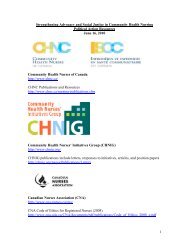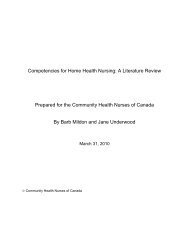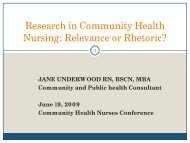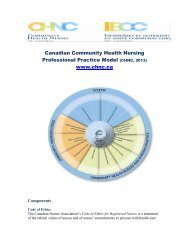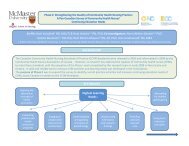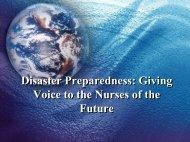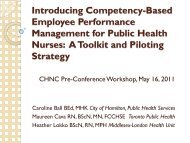Canadian Community Health Nursing Standards of Practice (CCHN ...
Canadian Community Health Nursing Standards of Practice (CCHN ...
Canadian Community Health Nursing Standards of Practice (CCHN ...
Create successful ePaper yourself
Turn your PDF publications into a flip-book with our unique Google optimized e-Paper software.
Workshop/Presentation<br />
Approximate Time<br />
Intended Audience<br />
Objectives<br />
1. Workshop 1: Introduction<br />
to the <strong>CCHN</strong> <strong>Standards</strong><br />
2 - 2.5 hours, depending on<br />
number <strong>of</strong> groups, time given<br />
to discussion, and time to<br />
report to full group<br />
<strong>Community</strong> health nurses<br />
• On staff<br />
• Newly employed<br />
Student nurses<br />
1. Provide background on the development <strong>of</strong><br />
the <strong>Standards</strong><br />
2. Develop knowledge <strong>of</strong> specific <strong>Standards</strong><br />
with examples from Home, Public, and<br />
<strong>Community</strong> <strong>Health</strong> <strong>Nursing</strong> <strong>Practice</strong><br />
3. Identify how the <strong>Standards</strong> can support<br />
practice, benefit organizations and contribute<br />
to the health <strong>of</strong> the community<br />
4. Identify the use <strong>of</strong> <strong>Standards</strong> in your<br />
community experience<br />
2. Workshop 2: Application<br />
<strong>of</strong> <strong>CCHN</strong> <strong>Standards</strong> in Team<br />
<strong>Practice</strong><br />
2- 3 hours, depending on<br />
number <strong>of</strong> groups, time given<br />
to discussion, and time to<br />
report to full group<br />
Nurses/<strong>Nursing</strong> teams with<br />
community experience/or with<br />
varying levels <strong>of</strong> education and<br />
experience (examples relate t<br />
Public <strong>Health</strong>)<br />
1. Reaffirm knowledge <strong>of</strong> the <strong>CCHN</strong> <strong>Standards</strong><br />
2. Situate the <strong>CCHN</strong> <strong>Standards</strong> in relation to<br />
other pr<strong>of</strong>essional requirements or<br />
expectations<br />
3. Identify how the <strong>CCHN</strong> <strong>Standards</strong> are<br />
presently being used in Public <strong>Health</strong><br />
4. Explore specific examples <strong>of</strong> how teams<br />
currently use the <strong>CCHN</strong> <strong>Standards</strong> in<br />
activities, tasks, or programs<br />
5. Develop examples <strong>of</strong> how teams could<br />
incorporate the <strong>CCHN</strong> <strong>Standards</strong> in next<br />
six months<br />
Step 4 Taking action<br />
Workshop 1 introduces the <strong>Standards</strong> and challenges<br />
participants to find their own examples in order to make<br />
the <strong>Standards</strong> meaningful for them. The relationship <strong>of</strong><br />
the <strong>CCHN</strong> <strong>Standards</strong> to provincial/territorial nursing<br />
standards is discussed. As a follow-up activity to the<br />
workshop, participants are asked to consider how the<br />
<strong>CCHN</strong> <strong>Standards</strong> can be combined with their regulatory<br />
nursing requirements and asked to report their findings at<br />
the next workshop. An evaluation form is provided.<br />
Workshop 2 encourages teams to apply the <strong>CCHN</strong><br />
<strong>Standards</strong> by developing examples from their practice for<br />
each Standard and planning how to increase use <strong>of</strong> the<br />
<strong>Standards</strong> in their practice. Liz Haugh <strong>of</strong> the Windsor-<br />
Essex County <strong>Health</strong> Unit contributed a tool showing the<br />
application <strong>of</strong> each <strong>CCHN</strong> Standard in Public <strong>Health</strong><br />
programs: “Department <strong>Practice</strong> Example Tool for<br />
<strong>Standards</strong>” that can be found in the resource section. This<br />
tool can be used to document the team’s initial examples.<br />
Then, as teams begin to define and harmonize their<br />
practice in terms <strong>of</strong> the <strong>CCHN</strong> <strong>Standards</strong>, they can update<br />
the tool on a regular basis to track changes. It might also<br />
be used to record objectives they want to achieve in a<br />
certain area. These characteristics make the tool a<br />
working document that practitioners maintain. The<br />
process <strong>of</strong> identifying and tracking practice changes<br />
related to each <strong>CCHN</strong> Standard is as important as the<br />
document itself.<br />
Download the powerpoint presentations from the CD<br />
and adapt them based on the learning needs assessment<br />
for your organization. The resource section provides<br />
additional sources <strong>of</strong> information for specific areas.<br />
Organizational Policies and <strong>Practice</strong>s.<br />
This section provides suggestions on how to integrate<br />
the <strong>CCHN</strong> <strong>Standards</strong> into organizational policies and<br />
procedures: hiring policy; position descriptions or<br />
pr<strong>of</strong>iles hiring interview guide; orientation material and<br />
performance appraisal.<br />
Hiring Policy: The organization may want to consider<br />
adding the following statement to recruitment<br />
advertisement for community health nursing positions.<br />
The statement informs potential applicants that they<br />
would be expected to display some awareness <strong>of</strong> the<br />
26 <strong>Community</strong> <strong>Health</strong> Nurses Association <strong>of</strong> Canada




